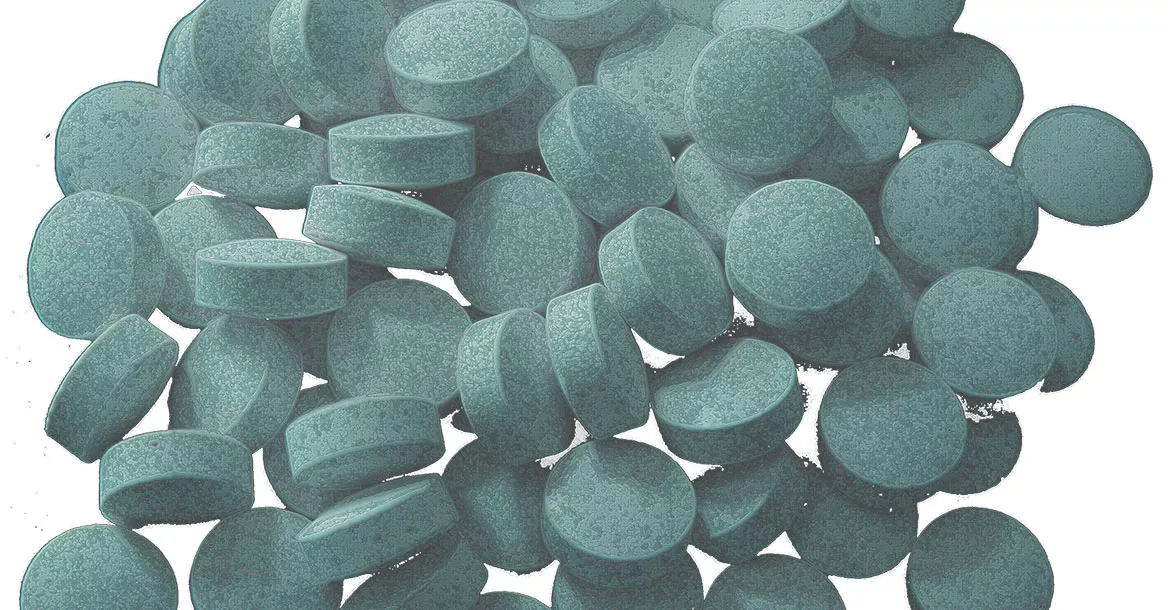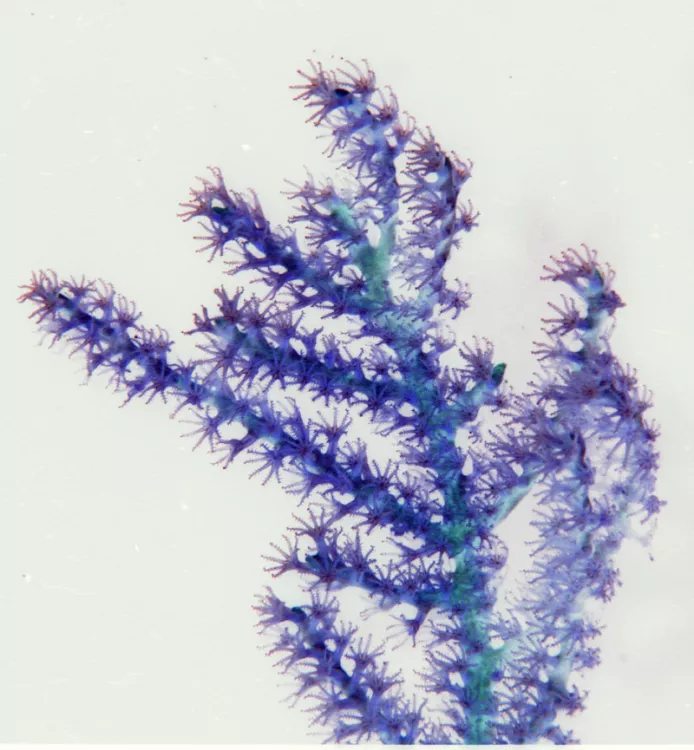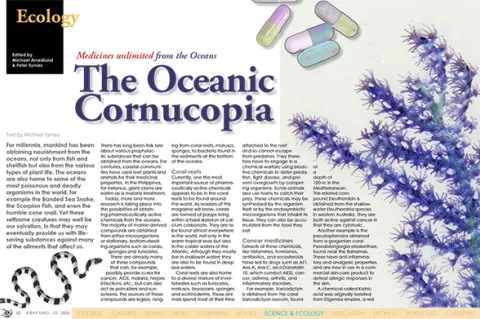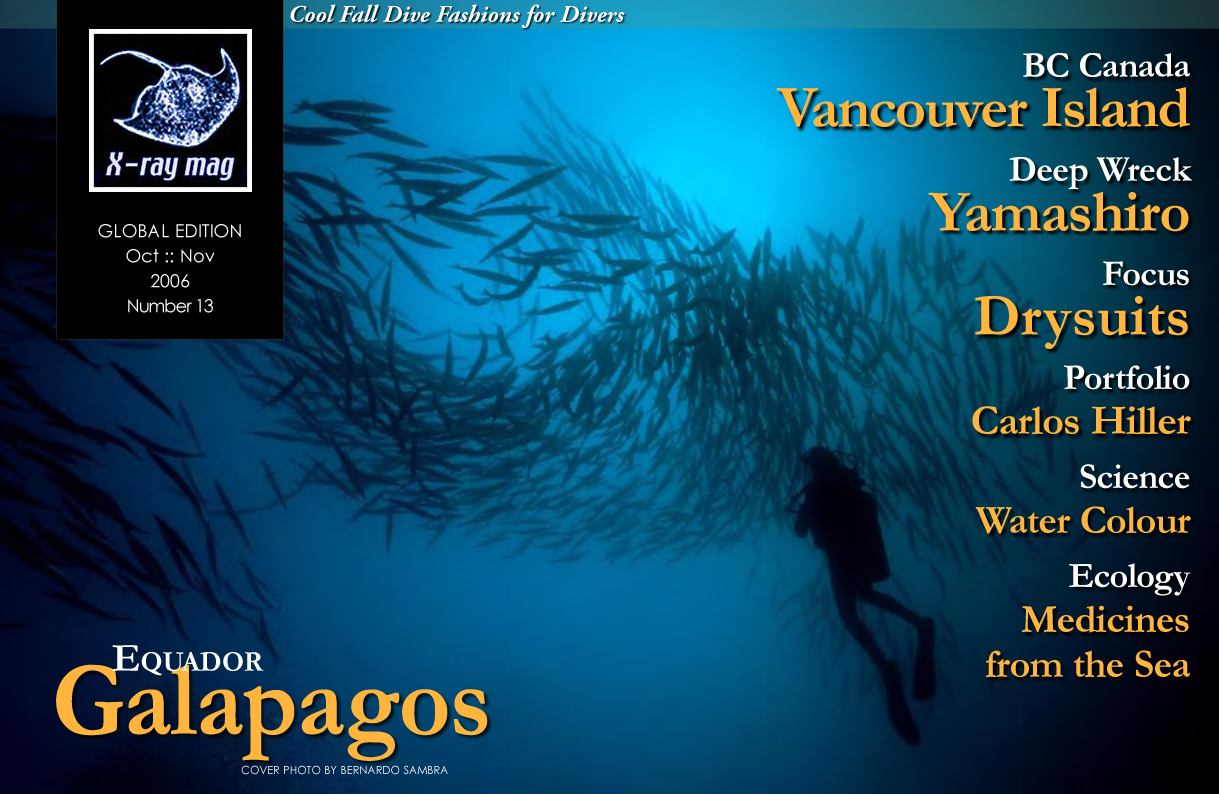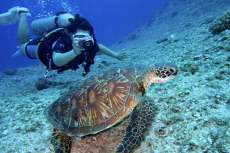For millennia, mankind has been obtaining nourishment from the oceans, not only from fish and shellfish but also from the various types of plant life. The oceans are also home to some of the most pois
Contributed by
There has long been folk lore about various prophylactic substances that can be obtained from the oceans. For centuries, coastal communities have used reef plants and animals for their medicinal properties. In the Philippines, for instance, giant clams are eaten as a malaria treatment.
Today, more and more research is taking place into the possibilities of obtaining pharmaceutically active chemicals from the oceans. The majority of marine-derived compounds are obtained from either microorganisms or stationary, bottom-dwelling organisms such as corals, sponges and tunicates. There are already many of these compounds that can, for example, possibly provide cures for cancer, AIDS, malaria, herpes infections, etc., but can also act as pain-killers and sun-screens. The sources of these compounds are legion, ranging from coral reefs, molluscs, sponges, to bacteria found in the sediments at the bottom of the oceans.
Coral reefs
Currently, one the most important source of pharmaceutically active chemicals appears to be in the coral reefs to be found around the world. As readers of this magazine will know, corals are formed of polyps living within a hard skeleton of calcium carbonate. They are to be found almost everywhere in the world, not only in the warm tropical seas but also in the colder waters of the Atlantic. Although they mostly live in shallower waters they are also to be found in deep sea waters.
Coral reefs are also home to a diverse mixture of invertebrates such as tunicates, molluscs, bryozoans, sponges and echinoderms. These animals spend most of their time attached to the reef and so cannot escape from predators. They therefore have to engage in a chemical warfare using bioactive chemicals to deter predation, fight disease, and prevent overgrowth by competing organisms. Some animals also use toxins to catch their prey. These chemicals may be synthesized by the organism itself or by the endosymbiotic microorganisms that inhabit its tissue. They can also be accumulated from the food they eat.
Cancer medicines
Extracts of these chemicals, like histamines, hormones, antibiotics, and secosteroids have led to drugs such as AZ1, Ara-A, Ara-C, and Dolostatin 10, which combat AIDS, cancer, asthma, arthritis, and inflammatory disorders.
For example, Sarcodictyin is obtained from the coral Sarcodictyon roseum, found at a depth of 100 m in the Mediterranean. The related compound Eleutherobin is obtained from the shallow-water Eleutherobia species in western Australia. They are both active against cancer in that they are cytotoxic .
Another example is the pseudopterosins obtained from a gorgonian coral Pseodoterigorgia elisabethae, found near the Bahamas. These have anti-inflammatory and analgesic properties, and are now in use in a commercial skin-care product to defeat allergic responses in the skin.
A chemical called Kainic acid was originally isolated from Digenea simplex, a red algae found in coral reefs off the coasts of Japan and Taiwan. This is used as an antiworming agent, and in neuroscience research in the modelling of epilepsy and Alzheimer’s disease. It is also used as a diagnostic chemical to investigate Huntington’s chorea, a rare but fatal disease of the nervous system.
Porifera
The Porifera, more commonly known as the sea sponges, are multicellular marine animals usually occurring in complex sessile colonies in which the porous body is supported by a fibrous framework. They are to be found in every ocean of the world, particularly the Antarctic, both in shallow waters as well as in the depths, including sea caves where there is little or no light. There are even some that live in fresh waters. Some 5000 species have already been identified. Most sea sponges attach themselves to coral, rocks and other hard surfaces along the ocean floor.
Sponges are home to huge amounts of bacteria, cyanobacteria, and fungi, and because a single sponge can be populated by dozens of different symbiotic bacteria that produce an extraordinary range of chemicals, they are ideal candidates for bioprospecting. These associated microorganisms have been shown in some cases to be responsible for the defensive chemicals produced by sponges. Many sponge species have elevated microbial populations.
An example of these chemicals are those that have been collected from the sponges of the Lithistid family, discovered at depths of 300 to 600 meters off the coast of Florida. Drugs extracted from them have been used not only to treat acute myelocytic leukemia and non-Hodgkin’s lymphoma but also for the treatment of herpes infections using the antiviral drug Ara-A.
Another sponge with an elevated microbial population which is exceptionally bioactive is the Halichondria okadai sponge which lives in remote tropical waters off the coast of Japan. This sponge contains halichondrin B, a chemical which has been described as ‘exquisitely potent’ in killing cancer cells. A synthetic version of this chemical, E7389, has been produced, which is currently being tested in humans for the treatment of non-small cell lung cancer and other cancers.
The drug functions by disrupting cell division. In a recent Phase II clinical study E7389 gave promises of a treatment for slowing and possibly reversing the spread of breast cancer. The deep sea sponge Lissodendoryx was later discovered at depths of 100 meters off the coast of New Zealand. This sponge contains halichondrins in greater concentrations than the shallow-water species.
The deep sea sponge Discodermia dissolute is found at a depth of 140 meters off the Bahamas. A compound, Discodermolide, which interferes with dividing cells, has been extracted from this sponge. It is an active agent against solid tumours, especially multi-drug resistant tumours. Phase I clinical trials have been completed
Furthermore, products from two other deep sea sponges are in pre-clinical development. These are Topsentin, which is an anti-inflammatory useful against arthritis and skin irritations, and also against colon cancer. It can also possibly be used in treating Alzheimer’s disease. It is obtained from the sponge Spongosporites ruetzleri, found at a depth of 300-600 m off the Bahamas. The second product is Dicytostatin-1, used against cancer. It is obtained from a sponge of the order Lithistida, family corallistadae, living off Jamaica at a depth of 440 m.
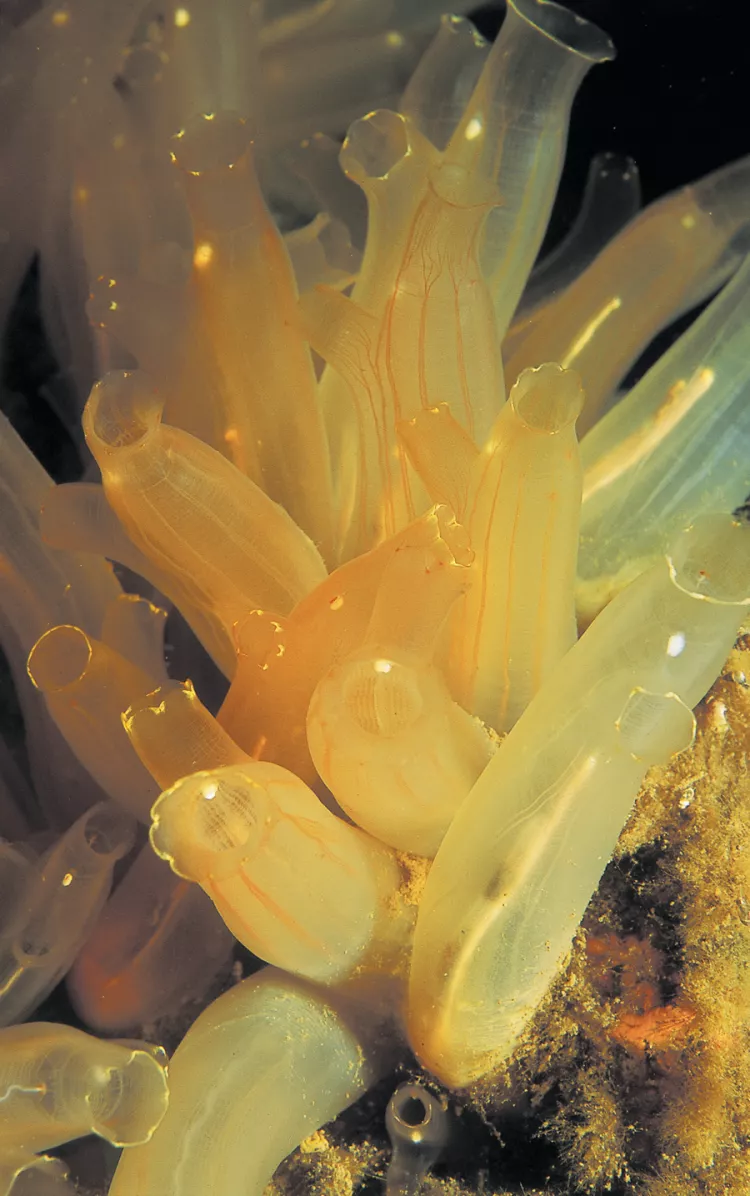
Tunicates
Tunicates, commonly called sea squirts, are marine animals that spend most of their lives attached to rocks or the bottoms of boats. The photosynthetic microbe Prochloron didemni lives as an endosymbiont inside the sea squirt Lissoclinum patella. This produces two compounds called Patellamide A and C, which are thought to have anti-cancer properties. These patellamides are small peptides that appear useful in treating some cancers.
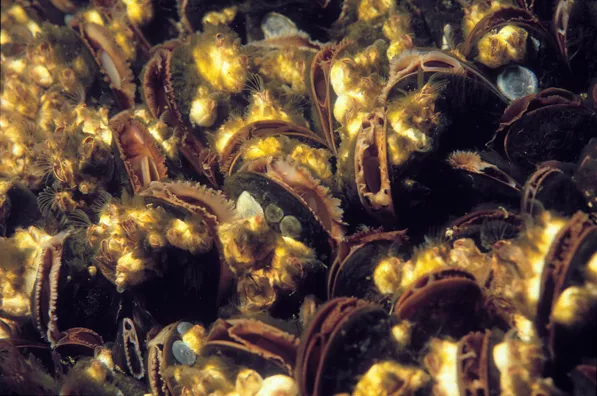
Molluscs
These consist of the gastropods (snails, slugs), the bivalves (clams, mussels) and the cephalopods (cuttlefish, octopuses). One of the most interesting gastropods from the medicine point of view is the beautiful but deadly cone snail, of which there are more than 500 known species, found primarily in coral reefs in warm, tropical waters but also in mangrove swamps. They harpoon other invertebrates with a concealed hollow tooth, though which they inject conotoxin venom. Despite its small size, it is only a few centimetres in length, it has enough venom to paralyse or kill a human.
The most scientifically interesting venoms are those produced by conus geographus and conus magus. Their venoms contain substances called conotoxins. These are small peptides, normally only 20-30 amino acids in length. This short length means that synthetic derivatives are relatively easy to manufacture. There are a number of different types of conotoxin, each acting on different receptors.
The molluscs’ venom was found to be able to block pain signals in the human spinal cord. Ziconotide, developed from the venom, works by blocking the calcium gateways of the nerve synapses, so that transmission of the pain signal to the brain is blocked. Ziconotide, also commercially known as Prialt®, was isolated from Conus magus.
One of the most significant developments is from an omega-conotoxin of conus geographus.
Using the snail’s natural conotoxin, a synthetic derivative called SNX-111 was produced. It has been shown to have analgesic properties, and has therefore the potential for being the basis for a new pain-relieving drug. Studies have already shown SNX-111 to be 100-1000 times more powerful than morphine, without many of the associated side effects
Conotoxins also have the potential to treat epilepsy and clinical depression.
Each species is able to produce more than a hundred unique toxins. Cone snails as a group may thus have more potential for new medicines than any other genus. So far, the venoms of only just over fifty species of cone snail have been investigated. As it takes 50-100 snails to obtain enough venom for analysis the environmental impact of removing cone snails must be considered.
Bacteria
Salinispora, a new class of marine gram-positive bacteria, have been isolated in large numbers from many different ecosystems, including the Caribbean Sea , the Red Sea, the oceans around Hawaii, and the Sea of Cortez, together with such extreme environments as the sediment on the ocean floor more than 1000 m down in the North Pacific Ocean. A substance, Salinosporamide A, has been isolated from these bacteria, which shows strong anti-cancer properties against melanoma, colon-, breast- and lung-cancer.
Plants
Just like the land plants from which we have previously obtained practically all our medicines, the plants that grow in and around the oceans have a potential as a source of biologically active chemicals. This potential, though, is nowhere as great as that for medicines produced from animal species.
One minor example is the extracts derived from the fruit of a mangrove species found on the coastal regions of the Andaman & Nicobar Islands, which shows both anti-diabetic and anti-diarrhoeal activities. Fractionation of the fruit can separate the anti-diabetic activity from the constipation-inducing activity.
Corals
Corals have a skeletal structure similar to that of bone, with a hard outer sheath and a spongy inner core. They are therefore well suited to be used as orthopaedic implants in bone grafting. At the present time, the best for this purpose are found to be the tropical genera Porites, Alveopora, and Goniopora. The bamboo corals of the family Isididae, genera Keratoistis and Isidella, which live more than 1000m down in the North Pacific Ocean, are also being used, as the dimensions of bamboo coral are almost identical to that of bone. They are still in preclinical development but have already been found to reduce the risk of mammalian disease.
The corals have also developed natural sunscreens to cope with long-term exposure to the high-intensity ultra-violet radiation penetrating shallow reef waters. This sunscreen, structurally unlike compounds in current use, has demonstrated great efficiency in absorbing and dissipating UV radiation in the damaging UV-B region of the spectrum. Luckily, these materials can now be synthetically produced, thus avoiding the destructive exploitation of natural resources.
Actinaria
The Actinaria, better known as the sea anemones, belong to the phylum Cnidaria which also includes the jellyfish, corals and hydras. The jelly fish and sea anemones have soft bodies and long, stinging, poisonous tentacles that they use to catch fish. They do this by paralysing the fish with venom sent out through stinging cells called nemocysts. The venom of some of the jelly fish is so strong that it can kill a person. However, it is the mechanism of the sting that is of interest, for the nemocysts can be used to inject drugs through the human skin.
It has been shown that the minuscule stingers of the sea anemones can be employed to deliver important pharmaceuticals painlessly through the skin of a patient. Research is going forward into imbedding a drug such as insulin into the stingers which can be mass-culled from the sea anemones. These are then made up into a cream which, when rubbed on the skin, activates the stingers to inject the drug. These tiny injectors, which are invisible to the naked eye, can deliver up to more than 100 thousand penetration points per square centimetre of skin contact. It is hoped that the method can be used to deliver chemotherapy drugs, antibiotics and anti-rejection drugs after organ transplant operations.
Cure for AIDS?
It will be seen that the oceans are potentially a huge source of medically important compounds. It is therefore necessary that we protect them from destructive fishing practices such as the trawling of the ocean beds. Otherwise, we might lose the chance to find just that substance or mechanism that could cure cancer or AIDS. But that’s another story. ■
Scripps Institution of Oceanography and UC San Diego’s School of Medicine have teamed up to hunt for new antibiotics on the ocean floor and get them to market
Bill Fenical, director of Scripps’ Center for Marine Biotechnology and Biomedicine, is sorting out how to make the potential new antibiotic discoveries effort more attractive to investors. He hopes an interdisciplinary approach to finding medicines from the sea could draw more resources. The biggest obstacle, he said, is that the largest donor of research grants, the National Institutes of Health, has stopped supporting antibiotic research.
This lack of support extends from a 25-year-old agreement to keep the National Institute of Allergy and Infectious Diseases - an NIH arm - from competing with private enterprise, he said.
“It’s completely out of date,” Fenical said. “Where are we in terms of developing new antibiotics? We are in trouble. My colleagues believe it is a national emergency.” Victor Nizet, associate professor of pediatrics at the Division of Infectious diseases at UCSD’s School of Medicine, said more than 50 percent of strains of bacteria are resistant to common, first-line antibiotics.
A dozen researchers are working on the interdisciplinary push to find new antibiotics. ■

